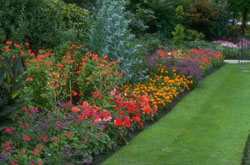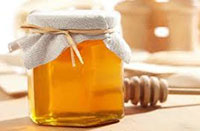Vegetable Garden
Colorado presents unique conditions that add to the complexity of gardening. With an average elevation of 6,800, high intensity sunlight, (usually) low humidity, and drastic weather changes, growing vegetables requires particular attention. CSU has several resources to help you get started with your garden and troubleshoot some of the most common issues in vegetable growing.
Follow this link to learn about gardening basics in Colorado.
Rainwater collection
Collecting rainfall from roofs and gutters, concrete patios and driveways can be a great way to meet the water needs of your garden and lawn. You can instal a very simple rainwater collection system using a barrel or plastic tank with a lid. Although Colorado’s water rights can restrict water collection, most homes are allowed to collect up to two rain barrels with a combined storage of up to 110 gallons to be used on the property.
Read more about rainwater harvesting here.
Container gardening
Container gardening can be a great alternative for small spaces. Flowers and vegetables can be planted in containers but it is improtant to create a substrate that allows for good root development, infiltration and nutrient movement. Irrigation and fertilization are priorities to keep vegetable plants happy in a container but the choice of the variety of the plants also plays a key role. Read more about container vegetable varieties by visiting this link.
CMG Garden Note #724 has some good information about container garden vegetables, when to plant them, scpacing and more. Read more by clicking here.
Vegetable growing Resources

- Food Smart Colorado – Nutrition, Food Safety, and Health Resources from CSU Extension
- Colorado Vegetable Planting Guide – A guide for the backyard vegetable garden, covering all regions of Colorado
- Preventing E. coli From Garden to Plate
- Storage Lengths and Temperatures of Harvested Vegetables
- Native flowers and bushes for Colorado landscapes
Selling Farm Products

- Colorado Farm to Market – navigate what regulations you must comply with to sell your products.
- CO Cottage Food Act – its easy to sell home-made/home-grown jams, eggs, honey, and more.
Fruit growing
Fruit Trees
Although fruit trees are most commonly grown on the Western slope of the state, fruit trees can still be grown in many places in Colorado. Semi dwarf varieties of fruit trees are often well suited for home gardens and smaller spaces if managed correctly. Some tree species like apples, sweet cherries, pears and Japanese plums are cross-pollinated, which means there needs to be at least two compatible cultivars in proximity to have good pollination. Other species like apricots, sour cherries, peaches, nectarines and European plums and prunes are generally self-pollinated.
Read the CMG GardenNote #771 – Growing Tree Fruit in Colorado Gardens to learn more about fruit tree care and establishment in Colorado.
Stone fruits
Peaches, plums, cherries and apricots can be grown at lower altitudes of Colorado. These trees require pest control periodically to keep them healthy. The table below lists some of the insect and diseases that affect Colorado stone fruits:
| Table 1. Insect and diseases that commonly affect Colorado stone fruits. | |||||
| Peach/Nectarine | Plum | Cherry | Apricot | ||
| Green peach aphid | X | X | Common and very damaging | ||
| Black cherry aphid | X | Can be very damaging | |||
| Black cherry aphid | X | Can be very damaging | |||
| Peach twig borer | X | X | Most common in Western CO | ||
| Oriental fruit moth | X | X | Palisade area only | ||
| Peachtree borer | X | X | X | X | Common and wisespread |
| Western cherry fruit fly | X | Present across much of the state | |||
| Pear slug | X | More common in some years | |||
| Cytospora canker | X | X | X | X | Wisespread and damaging |
| Coryneum blight | X | X | X | X | A threat with extended wet |
Treating trees to prevent insect damage can be done with insecticides available at many garden centers, although an integrated pest management approach is always recommended (Do not rely only on insecticides but use good managent practices to avoid plagues). Insecticide spraying should be done when pollinators are not actively visiting flowers to collect pollen. Bees and pollinators are usually active during teh day so early morning or evening spraying helps mitigate damage to non-target species.
Read the Backyard Orchard: Stone Fruits – 2.804 Fact sheet to learn more about common insects that affect stone trees and treatment recommendations.
Small Fruits
There is a wide variety of berries and small fruits that thrive in Colorado, whether you have a small acreage or garden. Some shrubs like serviceberries, currants, gooseberries and jostaberries are also commonly grown for their ornamental value and the services they provide for wildlife.
Red and yellow raspberries can be succesfully grown in Colorado. Some varieties of blackberries have been succesfully grown at lower elevations.
Strawberries are a common plant in Colorado Gardens with plenty of varieties to choose from. Strawberries are shorter lived than the rest of the small fruit bushes and require some different care strategies like protection from extreme heat or winds. They can also be prone to some of the same diseases as raspberries, tomatoes, peppers, eggplants, potatoes and bine crops, so when planting in garden beds make sure to rotate with different species to avoid soil borne diseases from past seasons. Learn more about growing strawberries by reading the CMG GardenNote #763 – Growing Strawberries in Colorado Gardens.
Resources
Resources & Helpful Information
SAM Webinars and Web Videos
- No-water Gardening for Higher Elevations (above 7500’) Webinar
- Safe Food Handling for Urban Gardeners
- Herbicide Carry Over and Fall Garden Tips
- Colorado Native Fruits
- Stone Fruits for Colorado below 7000’
- The Importance of Rootstock Selection when Growing Fruit Trees
- Apples for Colorado below 7000′
- Blueberries for Colorado Gardens
- Raspberries for Colorado below 7000′
- Bio-Intensive Growing for the Mountains
- High Tunnel Specialty Crop Production in Colorado
- Food Safety and Direct Marketing
- Native Plants – Saving You Time and Money!
SAM Newsletter Articles
- Protecting Plants from Wild Weather this Spring – spring 2021
- Can Specialty Crops and Solar Thrive Together? – spring 2020
- Transplanting Warm Season Vegetables – spring 2020
- Gardening Hacks for Extreme Colorado – summer 2019
- Microgreens Production
- More to the Business than Harvesting and Selling – winter 2019
- An Apple A Day – winter 2018
- Tips for Managing – winter 2018
- Canning 101 – fall 2017
- Grow Food-Grade Grain Sorghum – fall 2016
- What is Soil and How Does it Form? – spring 2015
- Soil Health and Vermicompost – spring 2015
- Grow Some Vegetables! – winter 2015
- High Tunnels: Strategies and Suggestions from Hidden Mesa – fall 2014
- Caution on Compost—Can it be too much of a good thing? – summer 2014
- Naturally Control Insects and Rodents – winter 2013
- Home Grown Wheat – fall 2013
- A Menu of Organic Fertilizers – fall 2012
- Grow Lavender! – summer 2012
- Setting Up a Drip Irrigation System – spring 2012
- Grow Hops in Colorado – fall 2011
- Herbicide Contaminated Organic Matter Kills Vegetables – summer 2011
- Understanding How Raspberry Plants Grow – spring 2011
- How to Grow Blueberries in Colorado – winter 2011
- Stop the Japanese Beetle – fall 2010
- Colorado Quinoa – fall 2010
- Use “weedy” Natives to Fight Noxious Weeds – summer 2010
- Know Your Farmer, Know Your Food – winter 2010
- What’s In Your Garden: Weed or Wonderful? – summer 2009
- Creating an Heirloom Vegetable Garden – spring 2009
- Native Edibles – fall 2009
Organic Growing
- National Organic Program – USDA Organic Certification information
- eOrganic– articles, videos, resources, Q&A, and more
- Vegetable Farmers Guide to Organic Certification – National Young Farmers Coalition guide for growers interested in the certification process
- USDA-NRCS – EQIP Organic Initiative (Environmental Quality Incentives Program) can assist in organic related conservation practices with technical and financial support





